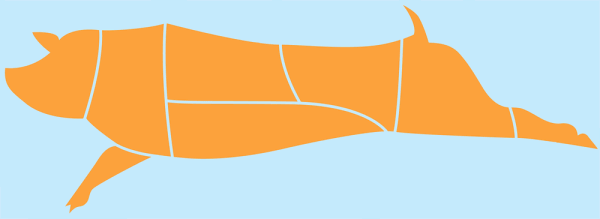Is Canada’s genetically engineered “Enviropig” headed for your plate?
Julia Prinselaar

It may be anticlimactic for those who picture transgenic animals as products of zany laboratory cut ’n pastes, but Canada’s first genetically engineered animal to be raised for food looks just like the ordinary farm pig that shares its DNA.
Dubbed “Enviropig,” its creators at the University of Guelph say it’s a boon to the environment because it excretes 30–70 percent less phosphorous than a regular pig.
But critics are skeptical of its practicality and concerned about its potential place on your dinner plate. The pig is currently undergoing reviews by Health Canada and the FDA for approval to be commercially bred and marketed in Canada and the U.S.
We spoke with Steven Liss, University of Guelph professor and Enviropig spokesperson, and Lucy Sharratt of the Canadian Biotechnology Action Network about a few of the issues raised by this complicated animal.
Regulatory/Access to information
U of Guelph says: The world of transgenic animals and their approval for human consumption is relatively new. Enviropig puts Canada at the forefront of this technology.
Flipside: How Health Canada determines if a GM animal is safe is not yet public knowledge. And so far, Guelph has not publicly released its Enviropig application to Health Canada.
Biosafety
U of Guelph says: Enviropig is a genetically enhanced Yorkshire pig. Liss says that scientific testing supports that both types of pigs are equally safe to breed, raise, and eat.
Flipside: As previous food safety scandals have shown us, when it comes to what we eat there’s no room for error. Genetically modified pigs have not yet been approved for human consumption and there has been no independent testing of Enviropig or the impact it could have on both food safety and the environment. Sharratt notes that genetically engineered foods don’t have labels, and there’s been little public oversight and little public debate over such items in our food supply. “The advent of Enviropig raises all of this at once.”
Livestock management and the environment
U of Guelph says: “The primary benefit is to the environment,” says Liss. Enviropig’s special digestive system allows it to better digest the phosphorous in its plant-based diet. This results in less phosphorus in the pig’s manure—and that means less phosphorus leaching into nearby waterways. Result: less algae growth and fewer poisoned fish.
Flipside: By reducing phosphorous output, farmers could theoretically raise more hogs while still meeting environmental regulations, so Enviropig may not actually lessen the stress on the environment. Enviropig also does nothing to address other issues associated with large-scale meat production like air quality problems or the spread of disease. And the phosphorus in a pig’s manure can already be reduced by up to 50 percent by simply adding common supplements to its diet.
Economics
U of Guelph says: Enviropig could save hog farmers money by reducing the costs associated with the phosphorousreducing supplements they already feed their animals and by cutting back land costs for spreading hog manure. Commercializing and licensing the pig could also mean big money for the groups—including the University of Guelph, Ontario Pork, and the Ontario Ministry of Agriculture, Food and Rural Affairs—that have invested at least $1.4 million in its creation.
Flipside: As a trademarked technology, the cost of Enviropig is likely to outweigh the cost of buying competitively priced, phosphorous-reducing supplements for regular pigs, argues Sharratt. She also believes the Enviropig could shatter consumer confidence in pork, an industry already in financial crisis. Meanwhile, taxpayers have shouldered the cost of developing the Enviropig through the use of public funds.